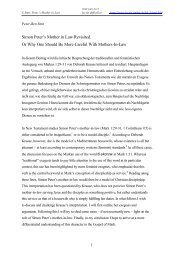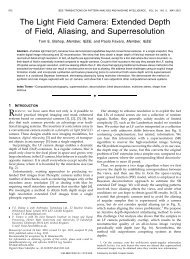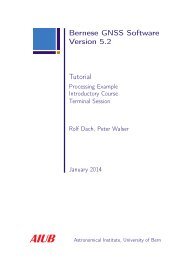Minimal Models of Adapted Neuronal Response to In Vivo–Like ...
Minimal Models of Adapted Neuronal Response to In Vivo–Like ...
Minimal Models of Adapted Neuronal Response to In Vivo–Like ...
Create successful ePaper yourself
Turn your PDF publications into a flip-book with our unique Google optimized e-Paper software.
Adapting Rate <strong>Models</strong> 2111<br />
firing rate [Hz]<br />
60<br />
40<br />
20<br />
60<br />
40<br />
20<br />
24<br />
20<br />
0 1 2<br />
0<br />
0 500 1000<br />
m [pA]<br />
Figure 4: LIF neuron with an adapting threshold, theory versus simulations. f-I<br />
curves plotted as in Figure 1A. Lines: Self-consistent solutions <strong>of</strong> equation f =<br />
(θ 0 + βf, s), with given by equation 2.3. Dots: Simulations <strong>of</strong> the full model,<br />
equations 2.7 and A.1, ( f sim ). Adaptation parameters: τ θ = 500 ms, B θ = 0.5mV·s<br />
(so that β = 0.25 mV·s). Neuron parameters and s values as in Figure 1A. <strong>In</strong>set:<br />
Sample <strong>of</strong> membrane potential and θ(t) for the point (m, s) = (550, 200) pA<br />
(time in seconds). Note that for this point, the output frequency is f ≈ 14 Hz,<br />
so that after the transient 〈θ〉 =θ 0 + βf ≈ 23.5 mV, as shown in the inset. Mean<br />
spike frequencies f sim assessed across 50 s, after discarding a transient <strong>of</strong> 10τ θ .<br />
2.3 Quantitative Comparison with Experimental Data. We have shown<br />
previously that the LIF neuron with AHP adaptation can be fitted <strong>to</strong> the experimental<br />
response functions <strong>of</strong> rat pyramidal neurons under noisy current<br />
injection (Rauch et al., 2003). We extended the analysis <strong>to</strong> the LIF neuron<br />
with an adapting threshold <strong>to</strong> find basically the same result. The results<br />
for the 26 rat pyramidal neurons considered for the analysis are summarized<br />
in Table 1 (see appendix B for details). Two examples are shown in<br />
Figure 5.<br />
The two adapting models can be made equivalent in the region <strong>of</strong> low<br />
frequencies, being both threshold-linear with slopes 1/α (AHP) and τ/Cβ<br />
(adapting threshold; see appendix C for details). This is confirmed by Table<br />
1, which shows that C and τ are the same for the two models and<br />
Cβ/τ = 4.46 pA·s, consistent with α = 4.3 ± 2.2.<br />
The two models differ in the value <strong>of</strong> the refrac<strong>to</strong>ry period, which is<br />
much shorter for the adapting threshold model. <strong>In</strong> fact, imposing τ r = 0<br />
only marginally affects the quality <strong>of</strong> the fits. This is because the LIF neuron<br />
with an adapting threshold has a square root behavior in m at intermediate<br />
and large frequencies (see equation C.1). To the contrary, a refrac<strong>to</strong>ry period
















